The main function of the house is to protect the owners from all kinds of dangers. And the cold, I can tell you, is just one of them. Having started repairs in a brick house, it is better at the same time to insulate its walls. This will keep your family warm even on the coldest days of winter. How to insulate brick wall from the inside I will tell you in my article.
I won't surprise anyone if I say that brick house - the most reliable house, but it has one drawback: the brick does not keep heat well. To avoid this, it is imperative to insulate your brick home. Many experts will answer you that it is more expedient to insulate the facade. brick house, because from the inside the insulation "eats" part of the room.
However, many people believe that such insulation inside is a rather time-consuming process and they resort to internal insulation of their apartments. But there are also several nuances here. Simply put, the insulation of brick walls from the inside of the house can be carried out in the case of:
- the presence of the conclusion of the expert commission that the facade of the building cannot be changed;
- behind the wall is unheated room (for example, an elevator shaft), in which it is impossible to equip insulation;
- if there is an expansion joint between houses behind the "cold wall".
It must be remembered that for the insulation of brick walls from the inside there are no heaters that cannot cope with their functions. The fact is that each individual insulation material has its own characteristics. In addition to this, they also differ in cost. When choosing a heater, you need to compare all the options available and suitable for you from the following:
- basalt slabs;
- cellulose insulation;
- mineral wool;
- polyurethane foam;
- styrofoam;
- plaster.
The differences between these materials are in their vapor permeability, thermal conductivity and moisture resistance - these are the main criteria for choosing a heater. Moisture resistance and vapor permeability are selected for the required type of installation, and climatic conditions must be taken into account. And the required layer thickness of the coating to be laid depends on the third parameter - thermal conductivity. It is only with him that the choice of insulating material begins.
Installation of material for insulation
Before starting to insulate a house, it is necessary to calculate the required width of the insulating layer for various materials and the number of layers of these materials.
- “Bare”: remove old insulation or plaster from it;
- inspect for irregularities, protrusions or differences in height;
- get rid of the above defects with a solution;
- clean after drying from dirt and dust;
- apply a primer;
- dry again;
After that, it is necessary to build a system of plumb lines and beacons - you should get a grid, we will be guided by it during installation works.
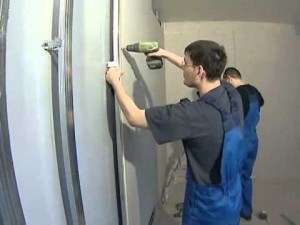
Today, the building materials market provides everyone with the necessary insulation. I will talk about some of them later.
Mineral wool
Mineral wool is often used as a brick insulation for many of its advantages: it retains heat well, and is quite profitable financially. But when installing it inside, you definitely need to know some of the nuances.
- you can lay plaster, or you can not lay it, but go the other way: fill vertical slats on the walls, the space between which will be narrower than the width of the insulation material. Why is this done if it was possible to resort to the first method? Since the mineral wool is afraid of moisture, and in order to prevent condensate vapors from settling in the thickness of the insulation (and the mineral wool will lose its insulating properties), the above work needs to be done. Therefore, as for me, it is better to choose the second option.
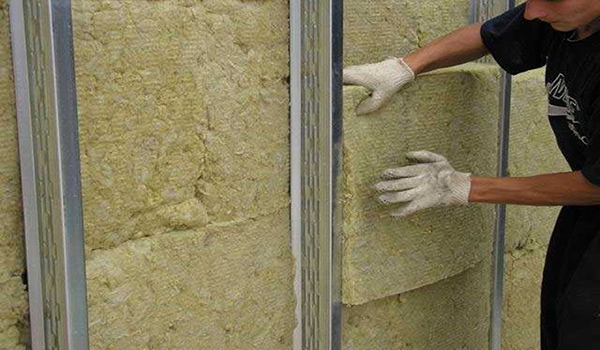
- next should be placed waterproofing material;
- and in conclusion - vapor barrier;
- finish of installation - finishing of insulated bricks. It can be plywood, lining, or any other material.
Styrofoam
At its low cost, foam is an effective and reliable insulating material. Excellent noise damper.
The process of installing foam plastic is simple.
- plaster the wall;
- put waterproofing material on it; polystyrene, like mineral wool, is afraid of moisture, and the consequences of water getting on this insulating material are exactly the same as those of the above material.

- only after these procedures can the foam be glued. Adhesive composition for this you need to apply it to the wall. Sheets styrofoam is laid close to each other, avoiding gaps. In the event of the formation of such, they need to be putty.
- now you can install waterproofing.
- completion of installation - wall finishing. It is carried out using the same materials as the walls, insulated with mineral wool.
Plaster
Wall insulation with plaster is the most time-consuming and polluting method. But at the same time, it is the cheapest.
You should know that in the insulation of brick walls from the inside of the house, it is necessary to apply several layers of plaster. They are applied directly to the wall itself.
The first layer of plaster to be applied is called spray. In terms of consistency, it is the most liquid solution and, following its name, it should be applied simply by spraying the wall with a certain amount of effort, since it is necessary that the solution gets into all the cracks and gaps in the wall. Pre-moisten the wall with water.

The second layer is priming, it is the most important in the work, because sets the quality of thermal insulation. Must have a pasty consistency. The second layer should be applied in several layers (stages), drying well each previous one before applying the next. This is done so that the soil is not sprinkled under its own weight. The thickness of the soil at the end of the work should be 50-60 cm.
The third layer - cover - a liquid solution based on fine sieved sand. This is a finishing coat in the process, which is approximately 4-5 cm thick. Necessary to obtain a perfectly flat surface.
So, today I introduced you to the procedure for the internal insulation of a brick house. As you can see, the work is not difficult, but it has many subtleties: from the expediency of insulation inside to the number of layers when covering a brick wall with plaster. But it is enough to make a little effort and the creation of warmth and comfort in your home will be provided. For my part, I guarantee an affordable and useful information in this article. Equip your home according to your desires and needs, make your home a fortress!
The video shows in practice how you can at home, using the minimum permissible set of tools.
The main thing that should be the basis of every home is comfort and warmth. No beautiful super-stylish interior can replace a comfortable existence in a pleasant environment with optimal humidity and optimal temperature difference, at which its readings at the floor surface are 2-4 ° higher than at the level of human height. Such a favorable atmosphere can be achieved only with high-quality insulation of all surfaces of the room (apartment, house, cottage) - ceiling, walls, floor.
Wall insulation is an important issue in solving the problem of keeping warm in a living room. If in the insulation process of an old building or a recently built, but requiring block, frame, wooden or slag cladding, it is better to apply the method of external work, then in a new, recently built, house made of high-quality material, it is better to use internal insulation. For example, the insulation of the walls of a brick house from the inside is quite justified with the ideal laying of walls made of expensive and beautiful bricks or, if you want to create a more comfortable existence in an apartment multi-storey building, in which it is impossible to insulate from the outside only the wall of one living room.
Before starting internal insulation work, it should be borne in mind that the main inconvenience of this type of work is the reduction in the area of \u200b\u200bthe room to be insulated, in contrast to the external method. But the process of wall insulation from the inside also has some advantages - significantly lower financial and labor costs compared to external insulation, no need to authorize any services to carry out insulation work and invite specialists for outdoor work.
Ways to insulate the walls of a brick house
There are several ways to achieve the desired heat saving of walls, which depend on the materials used in the insulation process:
- plaster;
- foamed plates (polystyrene, expanded polystyrene);
- mineral fiber mats (rolls or plates);
- liquid sprayed polyurethane foam.
It is necessary to dwell in more detail on each of these methods of wall insulation from the inside, having considered their pros and cons.
1. Plastering insulation works - the cheapest, but the most time-consuming and polluting method of insulation. Insulating plaster is applied in several stages:
- Wall surface preparation - cleaning from cracked and peeling plaster, paint or wallpaper, from old brickwork or construction dust from newly built but rather cold walls. Insulating plaster is an affordable way for many to insulate walls with their own hands.
- Reinforcement of thin (about 5 mm) strips on the surface intended for plastering to provide a gap between reinforcing mesh and wall surface.
- Placement of a reinforcing mesh, having cells up to 5 cm, over the entire area of \u200b\u200bthe wall for applying a strong layer of plaster without cracking.
- Spray (the initial layer of plaster) with a liquid, sour cream consistency, cement-sand mortar up to 1 cm thick in order to remove minor defects and unevenness of the brick surface, having previously moistened the wall with water.
- Primer - a plaster solution of pasty density is applied with a leveling layer (two or three), with a total thickness of 5-6 cm. Primer layers can be applied both by spraying and spreading, thoroughly drying each layer.
- Covering - the final layer of warm plaster, no more than 4-5 cm thick, is made with a liquid solution based on fine sifted sand, the purpose of the last layer is a perfectly flat surface.
2. Plates of expanded polystyrene materials (polystyrene or expanded polystyrene)  are used quite often as a heater for the inner surface of walls, including brickwork. More often, together with foamed polystyrene plates, as well as with mineral wool plates, mats or rolls, the walls of a brick house are insulated with plasterboard. Foam or expanded polystyrene plates, which have very low thermal conductivity, are also excellent sound absorbers. In addition, foamed polystyrene insulation is very profitable in price and easy to install, it is quite possible to insulate walls from the inside with foam or polystyrene with your own hands, even without special skills in construction. The main thing is to observe a simple technology of work:
are used quite often as a heater for the inner surface of walls, including brickwork. More often, together with foamed polystyrene plates, as well as with mineral wool plates, mats or rolls, the walls of a brick house are insulated with plasterboard. Foam or expanded polystyrene plates, which have very low thermal conductivity, are also excellent sound absorbers. In addition, foamed polystyrene insulation is very profitable in price and easy to install, it is quite possible to insulate walls from the inside with foam or polystyrene with your own hands, even without special skills in construction. The main thing is to observe a simple technology of work:
- applying a layer of plaster on a brick wall, if not;
- cleaning, wall preparation - removal of old wallpaper and paint, putty of possible cracks and large irregularities (small ones are leveled with a layer of glue), an obligatory deep penetration primer with antiseptic antifungal additives;
- coating with a layer of leveling putty, if necessary, and a primer;
- dilution of glue - strictly according to the instructions on the packages of the dry glue mixture, dilute thoroughly, without lumps, to the consistency of thick sour cream;
- covering only the wall surface with glue, with a smooth metal spatula, then work the surface with a notched (comb) spatula;
- gluing - glue the foam plates (expanded polystyrene) neatly in even horizontal rows, pressing tightly against the wall, monitoring the absence of deviations from the plane of the common leveled surface, do not additionally fix with dowels;
- the slabs should be laid very tightly, avoiding cracking.
Further work will depend on the topcoat:
When insulating with foam plastic under drywall, before gluing the boards, you should install the fastening brackets according to the marking (in increments of 40 or 60 cm, since the width of the sheets is 120 cm) for the subsequent installation of the frame. After laying the polystyrene on the wall, install the frame, attach sheets of drywall to it, which will serve as additional insulation. Putty the joints and caps of the screws. The covering is ready for painting or wallpapering.
If after the foam it is necessary to apply a putty, then you should first prime the plates, seal the joints with a putty, then apply the putty in an even layer using a putty knife, in one or two layers.
If a thin layer of plaster is conceived on top of the foam, then reinforce the reinforcing mesh made of fiberglass material with the thinnest layer of mortar (special plaster mixture of fine grain), and on top of it, after the first layer has dried, apply a second, finishing one.
3. Mineral wool, due to the rather loose structure of this material, is always carried out with subsequent coating with some kind of finishing panels, fiberboard, chipboard, MDF or plastic, as well as sheets of plywood or drywall. Having excellent heat-saving and fire-resistant qualities, mineral wool is afraid of moisture. Therefore, to prevent condensate vapors from settling in the thickness of the insulation and the loss of insulation efficiency, it is recommended to first fill the vertical slats on the wall with a step narrower than the width of the insulation mats. They are designed for the air gap, which will serve as an opportunity to shift the "dew point", that is, condensation of moisture towards the cold wall.
Then a vapor barrier (or waterproofing in a room with high humidity) should be placed over the entire wall area on top of the slats. Next, you need to install the frame for further placement of finishing panels or sheets, in the frame section, tightly lay the mineral wool, trying to avoid gaps (possible cold bridges). Then, over the entire insulated area of \u200b\u200bthe wall, place a vapor barrier, as a result, a reliably heat-saving "thermos" will be obtained. At the end of the process, you can attach finishing panels or coating sheets to the frame for putty (painting, wallpaper).
4. Thermal insulation with liquid sprayed insulation, usually polyurethane foam.
PPU is a universal type of modern high-tech insulation (similar to foam insulation and ecowool in terms of its characteristics).
This method is not yet widely used due to the rather high price of the insulation material. In addition, for spraying polyurethane foam, a special foam filling machine and certain skills are required for this job.
Before insulation liquid material it is necessary to prime, after cleaning, the surface of the wall. Then you should install the frame structure (made of wooden bars or metal guides), spray the entire space inside it with polyurethane foam insulation, trying not to go beyond the frame. If excess foam forms after swelling, carefully cut it off. In the future, you can fix any selected topcoat on the frame.
Having made the decision to insulate brick walls from the inside with the help of polystyrene plates, it is better to give preference not to foam plastic, but to a cheaper material, but to extruded polystyrene foam, since the latter has fire-resistant qualities (due to the filling of polymer granules with carbon dioxide, not natural, as in foam plastic) ...
If it is possible to choose which method of insulation work to use, internal or external, it is better to choose the latter. But if this is not possible, then the main thing for insulation from the inside is to provide reliable vapor barrier.
Experts do not recommend insulating a brick house from the inside without obvious reasons. First, it is less effective than external insulation. Secondly, high-quality internal insulation will "eat up" a lot of usable area. Thirdly, after such a procedure, it will be necessary to carry out additional interior decoration walls.
However, there are obvious advantages of internal insulation. First of all, this is the lower cost of this type of insulation, compared to external finishing. In addition, the appearance of the house will not be affected. Sometimes internal insulation is the only insulation option. This happens, for example, in a brick multi-storey building. Before starting the process of insulating the walls of a brick house, study the vapor transmission capacity of the material that you are going to use. It should be a heater, which has less steam permeability than a brick. This will contribute to less freezing of the wall masonry due to the isolation of moisture. In addition, mold and mildew will grow on damp walls under the insulation material. To avoid this, plaster the wall before finishing and treat it with a special antiseptic. Also, decide what is the reason for the insulation of the house from the inside - year-round residence or a temporary stay in the off-season. This will determine the choice of insulation.
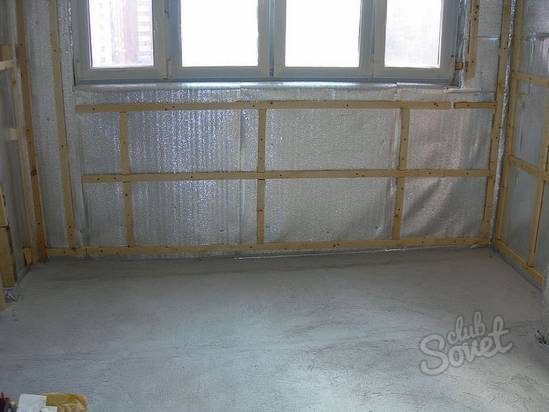

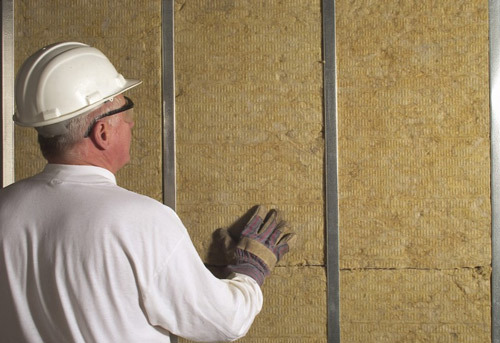
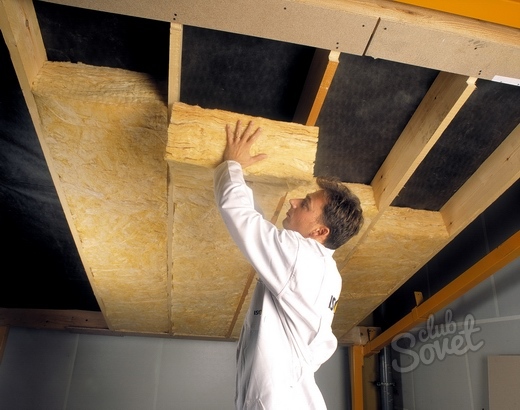

When insulating walls, ceiling and floor from the inside, do not forget about vapor barrier. All heaters are afraid of moisture.
For those who live in a brick house, the process of warming has become a mandatory procedure. Moreover, people began to carry out thermal insulation work inside. For this, many materials have been developed today, each of which has its own operational characteristics.
Wall insulation inside wooden house should be made in the form of a new wall, installed close to or with a gap. But in this case, you need to understand that the area of \u200b\u200bthe house will decrease slightly. This is especially noticeable in small houses.
Material selection
Before moving on to insulation, you need to decide on the material that is suitable for the walls. For this, it is necessary to take into account vapor permeability and moisture absorption. It is also necessary to take into account that seams and joint gaps are places where moisture and cold air penetrate into the room. Most often, the following types of heat insulators are chosen:
Heat insulator preparation and installation
When you have already decided on the choice of thermal insulation material and installation method, then you can go shopping. At the same time, you should not save on composites, since any changes in the installation technology may entail various troubles.
It is necessary to carry out work on the insulation of a brick house at a temperature of at least 20 degrees and at low air humidity. Before starting work, it is worth additionally drying the wall surface using a heat gun. All debris and dust that has formed should be removed. A properly prepared surface should not contain anything other than supporting structures.
Particular attention should be paid to areas where mold or mildew is present. For these purposes, it is necessary to remove everything and apply an antiseptic, a deep penetration primer to the wall. In this case, each layer must dry thoroughly.
But how the insulation of wooden windows takes place, and which materials are the best, this will help to understand
On video insulation the facade of a brick house from the inside with your own hands:
Depending on the type of heat insulator, work is performed to level the wall surface. For these purposes, water-repellent compounds are used. Wait until the putty is dry and reaches the required strength. This takes several days. Cover the already prepared wall with a primer in two layers, wait for it to dry. Then you can proceed to installing a heat insulator.
If we are talking about a wooden ceiling, then no lathing is required. For these purposes, space is required between the beams. All other work is carried out by analogy with the insulation of a concrete ceiling.
Floor insulation
The process of floor insulation in a brick house should take place directly at the stage of the construction itself. This method is called internal insulation and it is allowed to perform it at any time of the year. When performing a design calculation, it is necessary to take into account the presence of a basement, the number of floors, as well as the material for thermal insulation. Separately, it is worth noting the presence of a warm water floor, which is included in the heating systems of the house. In combination with insulation, it allows you to get additional heating of the home.
It may also be useful for you to learn about what a wooden entrance door looks like and how it works, and what the price of such work may be.
The following materials can be used to perform thermal insulation:
- mineral wool;
- expanded clay;
- ecowool;
- expanded polystyrene;
- extruded polystyrene foam;
- warm plaster;
- polyurethane foam.
You may also find it useful and interesting to learn about what material is needed to insulate the facade of the house, and
If you decide to make a wooden floor, the first step is to complete the underlay. For this, sand and rubble are used. After laying them out, careful compaction is required. Create a structure on top of the resulting pillow using a lag and cover it with waterproof plywood. A waterproofing layer is mounted on top.
The space that has formed between the lags must be filled with insulation. If desired, lay a layer of vapor barrier on top of the heat insulator. Then, using boards, a rough floor is made. A finishing is mounted on top of it, and at the end, a floor covering is installed. If the house has two floors, then the activities described above must be carried out for the second floor.
If a concrete floor is provided in the house, then first a cushion of rubble and sand is laid out, and then a rough screed is already performed.
A waterproofing layer is laid on top of it. Then you can proceed to the installation of the heat insulator. Most often, polystyrene or extruded polystyrene is used for these purposes. Although no one forbids the installation of other types of heat insulators. It is only necessary that the selected material has high strength and density.
It is also worth paying attention to how the
On the video process of floor insulation:
A vapor barrier is mounted on top of the insulation and poured finishing screed... Only now can we proceed to styling flooring... If the owners decide to use a warm water floor system, then the water pipes should be laid on top of the vapor barrier layer, and only then you can proceed to the finishing screed.
Insulation such as expanded clay can replace crushed stone and sand. It is lightweight and porous. It is made from burnt and crushed clay. Thanks to him, it is possible to level the surface, insulate it and protect it from moisture.
And here is how the aluminum facade glazing is insulated, you can see
The process of insulating a brick house inside is not particularly difficult. If you choose the right thermal insulation material and carry out all the work according to the planned plan, but you will succeed. The main thing is to approach everything with responsibility. And if it is difficult for you to carry out installation work alone, then it is better to invite an assistant, and one who has experience in this matter.
Buildings built of brick are considered the most durable and reliable, therefore, when building private houses, many use this particular building material. But despite the beautiful specifications, the brick has a fairly high thermal conductivity. Therefore, walls constructed from it need additional insulation... Next, it will be considered how to insulate the brick walls of a house from the inside with your own hands.
Features of insulation of brick walls
Thermal insulation of walls can be external and internal. External insulation is often used for old buildings, when the task is to decorate the walls with frame bricks, fiberboard, chipboard, etc. In this case, it is easier and more profitable to carry out external work than internal ones. If the building is new and does not need external cladding, then the best solution would be to insulate the brick wall from the inside.
Internal insulation of brick walls
It should be noted that work on internal thermal insulation reduces the useful area of \u200b\u200bthe room, however, this inconvenience is compensated for by the following advantages of this method:
- the cost of work is slightly lower than with external insulation;
- there is no need to obtain any permission from utilities;
- if desired, all work can be done independently, without the help of specialists.
Before insulating interior walls a brick house, it is necessary to take into account a lot of factors: the thickness of the masonry, the characteristics of the brick and the selected thermal insulation material, as well as the minimum annual temperature in the region where the house is built. If this is not done, then a very unpleasant situation can occur: condensation will appear between the insulation and the wall. And this will harm not only the thermal insulation layer, but also the finishing materials.
Firstly, when the insulation is exposed to moisture, its operational properties decrease. This is due to the appearance of cold bridges, along which heat will leave the house. Secondly, the high level of humidity is the cause of mold and mildew, which has a very bad effect not only on the decoration of the walls, but also on the health of all residents.
How to insulate a brick house from the inside?
It is necessary to choose a heat-insulating material for interior work very carefully, paying special attention to the following performance characteristics:
- Thermal conductivity - the lower its value, the better.
- Moisture absorption - characterizes the resistance of the material to the negative effects of moisture.
- Density - the weight of the insulation directly depends on it.
- Durability - indicates how much the selected material will retain its useful properties.
- Flammability is an important indicator for fire safety.
- Vapor permeability - the ability of a material to pass steam, which allows you to maintain an optimal microclimate inside the room.
- The complexity of installation work - the easier it is to work with the insulation, the faster the work on the creation of thermal insulation will take place.
- Environmental safety - indicates the naturalness of the material. For internal work, the insulation must be environmentally friendly, since the health of all family members will depend on this.
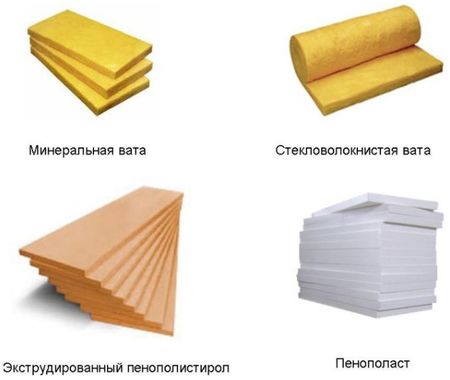
Brick wall insulation materials
Today on the building materials market you can find different kinds heaters, among which the most popular for interior work are:
- mineral wool;
- glass wool;
- extruded polystyrene foam;
- styrofoam;
- warm plaster.
The first place in popularity is mineral wool. This is due to the fact that it has low thermal conductivity, low weight and easy installation. The only drawback is high moisture absorption, which requires the installation of an additional moisture-protective layer when using it.
Glass wool is made from the same substance as ordinary glass. Unlike mineral wool, it has longer and thicker fibers, which gives it better mechanical strength. Glass wool is a completely ecological product that does not release harmful substances into the space when ignited.
Extruded polystyrene foam is the best option for both external and internal work. It does not emit harmful substances and has the lowest thermal conductivity of solid insulation... Its only drawback is its low strength and fragility.
Styrofoam, which is also in high demand, can be used as an external and internal insulation layer. If we compare it with mineral wool, then foam plastic has somewhat better thermal insulation qualities. This allows you to reduce the thickness of the insulation and, accordingly, save free space. However, the foam has some drawbacks that significantly limit the scope of its use. The main disadvantage is flammability. When burning, it emits substances that are quite hazardous to health, therefore it is quite dangerous to use it for internal wall insulation.
Warm plaster - relatively new finishing material... Its distinctive characteristic is the increased thermal insulation of the finished plaster layer. This is achieved by using granules of foam plastic, expanded clay, perlite, etc. as an aggregate, not sand. It should be noted that the thermal insulation properties of this material are rather low (for example, its thermal insulation is almost 2 times lower than that of extruded polystyrene foam). Therefore, with its help, you can only slightly insulate the walls inside a brick house with your own hands.
How to insulate a brick wall from the inside yourself?
For thermal insulation work, you may need the following tools and materials:

Brick wall insulation tool kit
- hammer drill with a set of drills;
- screwdriver;
- building level;
- roulette;
- furniture stapler;
- a hammer;
- scissors;
- putty knife;
- brush;
- insulation;
- glue solution;
- polyurethane foam;
- timber for lathing;
- deep penetration primer;
- antifungal impregnation;
- polyethylene film;
- dowels;
- nails.
You may not need some construction equipment. It all depends on what you plan to insulate the wall of a brick house from the inside. As an example, the internal insulation of brick walls with mineral wool and expanded polystyrene will be considered.
Insulation of a brick house from the inside with mineral wool
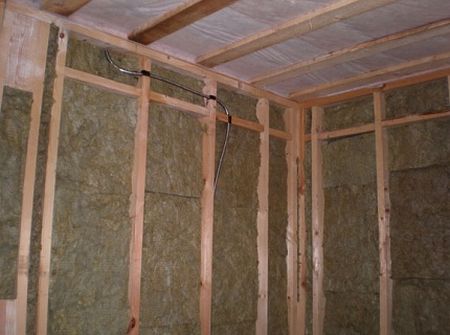
We insulate a brick house with mineral wool
Before installing the insulation, it is necessary to properly prepare the walls. If they have old finishing material (for example, plaster or wallpaper), then it must be removed. In a new building, it will be enough to clean the wall from the remnants of masonry mortar and dust with a regular brush or vacuum cleaner. Then the entire finishing surface must be treated with a deep penetration primer and an antifungal solution, which will protect the wall and insulation from the formation of fungus and mold.
After preparing the surface, a wooden crate is attached to it using dowels. The step of the lathing should be such that the wool slabs can fit between the beams without undercutting, deforming and creating voids. To prevent condensation from forming inside the insulation, it is recommended to fill wooden slats with a thickness of about 6 mm under the crate. With their help, an air gap is created, thanks to which the condensate will not harm the mineral wool.
At the next stage, using dowels with wide heads, the mineral wool slabs are attached to the wall, on top of which a layer of vapor barrier material (for example, plastic wrap) is laid. This material fastened to the insulation using smaller wooden beams. At the last stage, the entire structure is sheathed with plasterboard. After that, the wall can be processed with the selected finishing material.
Internal insulation of brick walls with expanded polystyrene
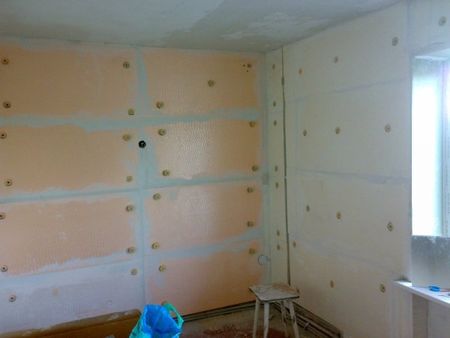
Wall insulation with expanded polystyrene
Expanded polystyrene boards have a high density, and with a thickness of more than 2 cm, they can be glued directly onto brickwork.
The sequence of work during the installation of expanded polystyrene is as follows:
- The base is leveled and treated with a deep penetration primer with antiseptic properties.
- After the primer has dried, a special adhesive solution for attaching the foam or tile adhesive is applied to the wall with a spatula. For better adhesion, you can walk over the glue with a needle roller.
- Expanded polystyrene boards are glued to a brick base with minimal gaps between adjacent elements and a spacing of vertical joints. For additional fixing of the insulation, you can use disc dowels.
- After the glue has hardened, all seams are treated with polyurethane foam or silicone sealant.
- Finishing of expanded polystyrene boards can be carried out with wallpaper or plaster.
Considering how to insulate a brick house from the inside, it should be noted that this is not difficult. The main thing is to choose the right insulation and install it according to the instructions.



